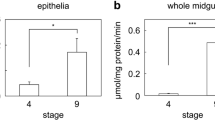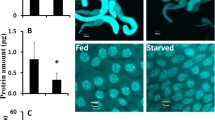Abstract
Diapausing pupae of tasar silkworm, Antheraea mylitta Drury were injected with ox pancreas insulin (40 I.U. per ml) on day 150 to observe the effect of this vertebrate hormone on diapause physiology. Insulin at the dose of 5 μl (0.2 I.U.) per pupa exhibited its positive impact by enhancing the incidence of male and female moth eclosion, female moth weight, egg production (laid + unlaid), and fecundity and shortening of time taken for emergence in both sexes. But, 10 μl (0.4 I.U.) dose of insulin increased only the female eclosion and reduced the time taken for emergence in each sex when compared to that of control. Administration of higher dose of insulin (10 μl per pupa) decreased the egg production and fecundity. No significant changes were observed in hatchability and incubation phenomena of eggs laid by the treated females. Further, both the doses of insulin were able to bring about the morphometric changes of testis and ovary by altering their shape and size during pupal diapause. Thus, it reveals from the preliminary findings that vertebrate insulin induces diapause physiology of A. mylitta.
Résumé
Des pupes en diapause du ver à soie Antheraea mylitta Drury ont reçu au 150e jour une injection d’insuline pancréatique de taureau (40 I.U. par ml) en vue d’enregistrer l’effet de cette hormone sur la physiologie de la diapause. L’insuline à la dose de 5 μl (0,2 I.U.) par pupe a eu un impact positif en augmentant l’incidence de l’éclosion chez les populations mâles et femelles, le poids de la femelle, la production d’oeufs (pondu et non-pondu) et la fécondité ainsi qu’un temps réduit d’émergence chez les deux sexes. Mais une dose de 10 μl (0,4 I.U.) d’insuline a accru seulement l’éclosion de la femelle et réduit la durée jusqu’à l’émergence pour chaque sexe comparativement à celle du témoin. L’administration d’une dose plus élevée d’insuline (10 μl par pupe) a réduit la production d’oeufs et la fécondité. Aucun changement significatif n’a été observé dans l’éclosion et l’incubation d’oeufs pondues par les femelles traitées. En outre, toutes les deux doses d’insuline ont entraîné des changements morphométriques des testicules et des ovaires en modifiant leur forme et leur taille durant la diapause pupale. Par conséquent, ces résultats préliminaires révèlent que l’insuline des vertébrés induit une diapause chez A. mylitta.
Similar content being viewed by others
References
Beck, S. D. (1971) Insect Photoperiodism. 2nd edn., Academic Press, New York.
Bodnaryk, R. P. (1987) Dual control of pupal diapause by cyclic nucleotides in the bertha armyworm, Mamestra configurata Wlk. J. Insect Physiol. 3 3, 33–37.
Bollenbacher, W. E., Katahira, E. J., O’Brien, M., Gilbert, L. I., Thomas, M. K., Agui, N. and Baumhover, A. H. (1984) Insect prothoracicotropic hormone: Evidence for two molecular forms. Science 224, 1243–1245.
Chaudhuri, A. and Medda, A. K. (1987a) Effect of thyroxine on protein, RNA and DNA contents of ovary of silkworms, Bombyx mori L. at larval, pupal and adult stages of development and production of eggs. Zool. Jb. Anat. 115, 85–90.
Chaudhuri, A. and Medda, A. K. (1987b) Thyroxine induced alterations in protein and nucleic acid contents of fat body of female silkworms during different developmental stages. Insect Sci. Applic. 8, 43–48.
Davis, K. T. and Shearn, A. (1977) in vitro growth of imaginai disks from Drosophila melanogaster. Science 196, 438–440.
Denlinger, D. L. (1985) Hormonal control of diapause. InComprehensive InsectPhysiology Biochemistry and Pharmacology (Edited by Kerkut, G. A. and Gilbert, L. I.), vol. 8, pp. 353–412. Pergamon Press, Oxford.
Falkmer, S., Carraway, R. E., El-Salhy, M., Emdin, S. O., Grimelius, L., Rehfeld, J. F., Reinecke, M. and Schwartz, T. F. (1981) Phytogeny of the gastroenteropancreatic neuroendocrine system. A review with special reference to the occurrence of CCK-like and neurotensin-like polypeptides in lower vertebrates and invertebrates. UCLA Forum Med. Sci. 23, 21–42.
Falkmer S., Emdin S., Havu N., Lundgren, G., Marques, M., Ostberg, Y., Steiner, D. F. and Thomas, N. W. (1973) Insulin in invertebrates and cyclostomes. Amer. Zool. 13, 625.
Gorbman, A. and Bern, H. A. (1974) A Text Book of Comparative Endocrinology. Wiley Eastern Private Limited, New Delhi.
Grieneisen, M. L., Warren, J. T., Sakurai, S. and Gilbert, L. I. (1991) A pupative route to ecdysteroids: Metabolism of cholesterol in vitro by mildly disrupted prothoracic glands of Manduca sexta. Insect Biochem. 21, 41–51.
Ishizaki, H. and Suzuki, A. (1988) An insect brain peptide as a member of insulin family. Horm. Metabol. Res. 20, 426–429.
Jhoti, H., McLeod, A. N., Blundell, T. L., Ishizaki, H., Nagasawa, H. and Suzuki, A. (1987) Prothoracicotropic hormone has an insulin like tertiary structure. Febs Letters 219, 419–425.
Kawakami, A., Kataoka, H., Oka, T., Mizoguchi, A., Kimura-Kawakami, M., Adachi, T., Iwami, M., Nagasawa, H., Suzuki, A. and Ishizaki, H. (1990) Molecular cloning of the Bombyx mori prothoracicotropic hormone. Science 247, 1333–1335.
Kramer, K. J. (1980) Insulin-like and glucagon like hormone in insects. In A J eurohormonal Techniques in Insects (Edited by Miller, T. A.), pp. 117–136. Springer Verlag, Heidelberg
Kramer, K. J. (1985) Vertebrate hormones in insects. InComprehensive Insect Physiology Biochemistry and Pharmacology (Edited by Kerkut, G. A. and Gilbert, L. I.), vol. 7, pp. 511–536. Pergamon Press, Oxford.
Kramer, K. J., Childs, C. N., Speirs, R. D. and Jacobs, R. M. (1982) Purification of insulin-like peptides from insect haemolymph and royal jelly. Insect Biochem. 12, 91–98.
Lawrence, P. O. (1991) Hormonal effects on insects and other endoparasites in vitro. In Vitro Cell Dev. Biol. 214, 487–496.
LeRoith, D., Adamo, M., Shemer, J., Waldbillig, R., Lesniak, M. A., dePablo, F., Hart, C. and Roth, J. (1988) Insulin-related materials in the nervous system of vertebrates and non-vertebrates: Possible extrapancreatic production. Horm. Metabol. Res. 20, 411–420.
LeRoith, D., Shiloach, J., Heffron, R., Rubinovitz, C., Tanenbaum, R. and Roth, J. (1985) Insulin- related materials in microbes. Similarities and differences from mammalian insulins. Can. J. Biochem. Cell Biol. 63, 839–849.
Magadum, S. B. and Hooli, M. A. (1989) Effect of insulin on the poly-voltine silkworm, the pure Mysore breed oîBombyx mori L. Sericologia 29, 17–28.
Maier, V., Steiner, P., Fuchs, J., Pfeifle, B., Mezger, M. and Pfeiffer, E. F. (1988) Isolation and partial characterization of insulin of the honeybee (Apis mellifica). Horm. Metabol. Res. 20, 421–425.
Morohoshi, S. and Ohkuma, T. (1968) The change of voltinism in Bombyx mori L. by injection of either adrenaline or insulin—Preliminary note. J. Sericult. Sci. Japan. 37, 274–280.
Mosna, G. and Barigozzi, C. (1976) Stimulation of growth by insulin in Drosophila embryonic cells in vitro. Experientia 32, 855–856.
Nagasawa, H., Kataoka, H., Isogai, A., Tamura, S., Suzuki, A., Ishizaki, H., Mizoguchi, A., Fujiwara, Y. and Suzuki, A. (1984) Aminoterminal amino acid sequence of the silkworm prothoracicotropic hormone: Homology with insulin. Science 226, 1344–1345.
Nagasawa, H., Kataoka, H., Isogai, A., Tamura, S., Suzuki, A., Mizoguchi, A., Fujiwara, Y., Suzuki, A., Takahashi, S. Y. and Ishizaki, H. (1986) Amino acid sequence of a prothoracicotropic hormone of the silkworm Bombyx mori. Proc. Nat. Acad. Sci. USA 83, 5840–5843.
Seecof, R. C. and Dewhurst, S. (1974) Insulin is a Drosophila hormone and acts to enhance the differentiation of embryonic Drosophila cells. Cell Diff. 3, 63–70.
Sinha, A. K. and Chaudhuri, A. (1992) Factors influencing the phenology of different broods of tropical tasar silkworm, Ant heraea mylitta Drury (Lepidoptera: Saturniidae) in relation to its emergence and post emergence behaviour. Environ. Ecol. 10, 952–958.
Steele, J. E. (1985) Control of metabolic processes. In Comprehensive Insect Physiology Biochemistry and Pharmacology (Edited by Kerkut, G. A. and GilbertL. I.), vol. 8 pp. 99–145. Pergamon Press, Oxford.
Tager, H. S., Markese, J., Kramer, K. J., Speirs, R. D. and Childs, C. N. (1976) Glucagon-like and insulinlike hormones of the insect secretory system. Biochem. J. 156, 515–520.
Thorpe, A. and Duve, H. (1984) Insulin and glucagon-like peptides in insects and molluscs. Mol. Physiol. 5, 235–260.
Author information
Authors and Affiliations
Rights and permissions
About this article
Cite this article
Sinha, A.K., Chakraborty, D. & Chaudhuri, A. Insulin-Induced Effect on Diapausing Pupae of Tropical Tasar Silkworm, Antheraea Mylitta Drury (Lepidoptera: Saturniidae). Int J Trop Insect Sci 14, 707–712 (1993). https://doi.org/10.1017/S1742758400018166
Received:
Accepted:
Published:
Issue Date:
DOI: https://doi.org/10.1017/S1742758400018166




